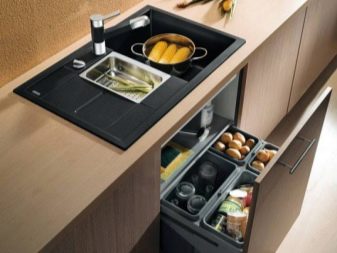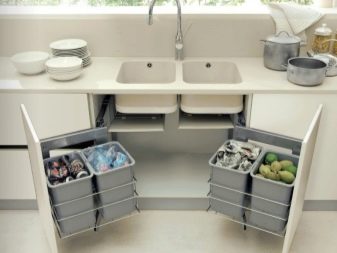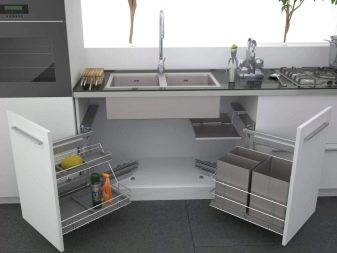Types and characteristics of sliding mechanisms in a kitchen corner cabinet

The modern kitchen is designed to save people's time and energy. Therefore, its content is constantly being improved. Gone are the days when there were only shelves in the cabinets. Now, instead of them, there are all kinds of mechanisms. But there is a place that is difficult to imagine with them. These are corner sections. When designing, questions always arise about the rationality of their use. In this case, all kinds of retractable devices come to the rescue.
They are needed in order to facilitate access to the most remote areas, place a large number of items there, making the process of using them more convenient.
Possibilities of use
Sections are considered to be corner sections, with the help of which parts of an L-shaped or U-shaped kitchen are joined. The possibilities of filling them depend on:
- positions - the choice of mechanisms for the lower sections is wider due to the greater depth;
- purpose - for washing or drying, for dishes, food or household chemicals there are adapted devices;
- finding building objects in them (wide boxes, the presence of a large number of pipes can interfere with the installation and extension of mechanisms);
- the shape, size of the cabinets and the way they are opened.




The cabinets used can be of two options.
- Polygon, which has either one wide door or two-piece. The wide door opening method can be conventional. The façade, consisting of two parts, can be folded like an accordion to the side. All kinds of elevators in this case are not used due to the impossibility of fastening. The size of the wide sides is 600 mm.
- In the form of a rectangular docking section, to which another joins, forming a right angle. The door can be retractable or hinged. The length of such a section is usually 1000, 1050 or 1200 mm. In this case, the width of the door, respectively, can be 400, 450 and 600 mm.
It is possible to do less, but it is impractical - then only narrow objects and certainly not mechanisms will be able to enter it.


Upper tier
Most often, a dish dryer is made in the upper cabinet above the sink. In fact, this is correct. But not very convenient. As a rule, it is quite deep, and it is convenient to place dishes only on the edge. It is irrational to set the second drying level, because its inner corner will be located even further. It is better to place the dryer in the closet next door..
The most convenient mechanisms in this case will be rotary (they are also called "carousels").
They may be:
- fixed inside the cabinet (the axis connecting all levels can be located in the center or on the side, so that wider things can be placed);
- attached to the door (in this case, the levels are semicircles).


Depending on the shape of the cabinet, the carousel shelves are:
- round;
- adapted, with a recess (before closing, all shelves must be turned with a recess forward, otherwise the cabinet will not close).


Usually, stainless steel is used for the manufacture of rotary mechanisms, less often wood. The bottom of the levels can be solid or mesh (not suitable for small items, but helps to ventilate the air). The bottom and other parts made of plastic are less reliable and will last less.
They can be divided by the number of levels:
- two are suitable for cabinets with a height of 720 mm;
- three - for 960 mm;
- four - for the table section (installed on the table top), but if you need to place tall things, one level can be removed for a while.
The swivel mechanisms do not use the entire interior space up to the corners. But they make it more convenient to use - for this you just need to turn the level and take the desired item.



Lower modules
If a sink is installed in the lower kitchen cabinet or most of it is occupied by pipes, then there are few options for pull-out systems. It can be:
- trash bins, storage and sorting containers;
- all kinds of bottle holders, holders or baskets for household chemicals.
Throwing garbage into a bucket placed in a closet is as inconvenient as pulling it out of there every time. To facilitate the process and get rid of misses, you can use the buckets, fixed in this way: when you open the door, the bucket goes out, and the lid remains inside.
A regular bucket can be replaced with a pull-out system with containers. They can be used both for sorting garbage and for storing vegetables. They all have lids and are made of plastic. They are easy to remove and wash.




But also the place under the sink can be used to store cleaning products, brushes, napkins. Items can be stored in containers or special holders. For the safety of children, there are special devices with locks - hazardous liquids are placed in them.
If the mechanism is attached only to the frame (sidewall or bottom), it can also be fixed in the beveled corner section, only it will have to be pulled out manually, without opening the door.
If the corner cabinet is empty, there are many more options for filling it.
Drawers
They can be safely positioned in the beveled section. Of course, the width of the drawer is the same along its entire length, and does not cover the side areas of the cabinet. But using them is much more convenient. Tall ones are intended for large objects, an additional railing will help to keep them. And the low ones are for cutlery and other little things.
The boxes can also be installed in a docking cabinet by rearranging the side of the frame. The main thing is that the handles of the perpendicular cabinet do not interfere with the drawers.


"Magic corners" and "carousels"
The lower cabinets can use the same swivel mechanisms as the upper ones. Only the size is matched.
Another interesting device is pull-out shelves. To make the turning process easy, they are given a special shape. Small bumpers help fix objects. The shelves can be pulled out one by one or at the same time.


There is a special system of baskets located at different levels. Thanks to this, you can put dishes in them of different heights and sizes. The whole structure moves smoothly and silently, as soon as the door is opened.
It is pleasant and convenient to use all of the above devices. They have only one drawback - they significantly increase the cost of the furniture in which they are installed. Years of convenience make up for that, however.


How to choose fittings?
For the internal structure of any cabinet to work well, you need high-quality fittings.
- Hinges - provide comfortable, silent door closing. In the case of pull-out systems, the opening angle of the hinge should be as large as possible.
- Guides or Metaboxes - needed for smooth extension of drawers and baskets, as well as closing them without cotton. It will be better if they, like the hinges, are equipped with door closers.
- Pens - must be comfortable and withstand a lot of weight. In the case of docking modules, flush-mounted or hidden models are preferable.
- Various baskets, shelves and levels... The material from which they are made is important here. It should be durable, safe and easy to clean.
Metal is preferred over plastic. Matte surfaces are more practical than shiny ones.




When choosing fittings, first of all, you need to be guided by reliability and convenience, and only then design.
For ideas of pull-out mechanisms in kitchen corner cabinets, see the following video.













The comment was sent successfully.